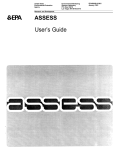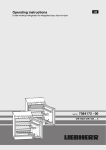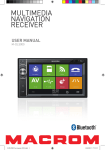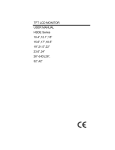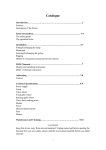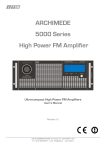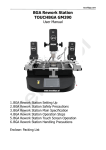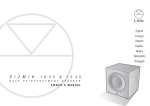Download User Manual for Model SR-L6111W-PA Under-Counter
Transcript
Operating Instructions Laboratory Refrigerator SR-L6111W Please read these instructions carefully before using this product, and save this manual for future use. See page 18 for all Model No. 0 English Note: 1. No part of this manual may be reproduced in any form without the express written permission of our company. 2. The contents of this manual are subject to change without notice. 3. Please contact our company if any point in this manual is unclear or if there are any inaccuracies. © Panasonic Healthcare Co., Ltd. 2012 All rights reserved. CONTENTS PRECAUTIONS FOR SAFE OPERATION P. 2 CAUTIONS FOR USAGE P. 6 ENVIRONMENTAL CONDITIONS P. 7 REFRIGERATOR COMPONENTS P. 7 INSTALLATION P. 10 START-UP OF UNIT P. 11 OPERATING INSTRUCTIONS P. 12 ALARMS AND SAFETY FUNCTIONS P. 15 DEFROSTING P. 15 MAINTENANCE P. 16 TROUBLESHOOTING P. 17 DISPOSAL OF UNIT P. 17 SPECIFICATIONS P. 18 PERFORMANCE P. 18 SAFETY CHECK SHEET P. 19 1 English PRECAUTIONS FOR SAFE OPERATION It is imperative that the user complies with this manual as it contains important safety advice. Items and procedures are described so that you can use this unit correctly and safely. If the precautions advised are followed, this will prevent possible injury to the user and any other person. Precautions are illustrated in the following way: WARNING Failure to observe WARNING signs could result in a hazard to personnel possibly resulting in serious injury or death. CAUTION Failure to observe CAUTION signs could result in injury to personnel and damage to the unit and associated property. Symbol shows; △ this symbol means caution. this symbol means an action is prohibited. ● this symbol means an instruction must be followed. Be sure to keep this manual in a place accessible to users of this unit. < Label on the unit > This mark is labeled on the cover in which the electrical components of high voltage are enclosed to prevent electric shock. The cover should be removed by qualified engineers or service personnel only. 2 English PRECAUTIONS FOR SAFE OPERATION WARNING Do not use the unit outdoors. Current leakage or electric shock may result if the unit is exposed to rain water. Only qualified engineers or service personnel should install the unit. Installation by unqualified personnel may cause electric shock or fire. Be sure to install the unit on a sturdy floor. If the floor is not strong enough or the installation site is not adequate, injury may result from the unit falling or tipping over. Never install the unit in a humid place or a place where it is likely to be splashed by water. Deterioration of the insulation may result which could cause current leakage or electric shock. Never install the unit in a flammable or volatile location. This may cause explosion or fire. Never install the unit where acid or corrosive gases are present as current leakage or electric shock may result due to corrosion. Make sure a dedicated power source is used as indicated on the rating label attached to the unit. Make sure to remove dust from the power supply plug before inserting in a power source. A dusty plug or improper insertion may pose a hazard. Use a power supply outlet with ground (earth) to prevent electric shock. If the power supply outlet is not grounded, it will be necessary to have qualified engineers install a ground. Never ground the unit through a gas pipe, water main, telephone line or lightning rod. Such grounding may cause electric shock in the case of an incomplete circuit. Do not insert metal objects such as a pin or a wire into any vent, gap or any outlet for inner air circulation. This may cause electric shock or injury by accidental contact with moving parts. Never store volatile or flammable substances in this unit. This may cause explosion or fire. Never store corrosive substances in this unit. This may lead to damage to the inner components or electric parts. If this unit is to be used for storing poisons, radioactive material or other harmful products, ensure that it is in a safe area. Failure to do so may lead to an adverse effect on the health of personnel in the area and the local environment. In this case, a request for repair or maintenance will necessitate a safety check sheet for maintenance personnel. 3 English PRECAUTIONS FOR SAFE OPERATION WARNING Always disconnect the power supply to the unit prior to any repair or maintenance of the unit in order to prevent electric shock or injury. Ensure you do not inhale or consume medication or aerosols from around the unit at the time of maintenance. These may be harmful to your health. Never splash water directly onto the unit as this may cause electric shock or short circuit. Never disassemble, repair, or modify the unit yourself. Any such work carried out by an unauthorized person may result in fire or injury due to a malfunction. Disconnect the power supply plug if there is something wrong with the unit. Continued abnormal operation may cause electric shock or fire. If the unit is to be stored unused in an unsupervised area for an extended period, ensure that children do not have access and that doors cannot be closed completely. The disposal of the unit should be accomplished by appropriate personnel. Always remove doors to prevent accidents such as suffocation. Make sure to prepare a safety check sheet when you request any repair or maintenance for the safety of service personnel. Select a level and sturdy floor for installation. This precaution will prevent the unit from tipping. Improper installation may result in water spillage or injury from the unit tipping over. Connect the unit to a power source as indicated on the rating label attached to the unit. Use of any other voltage or frequency other than that on the rating label may cause fire or electric shock. Fix the shelves securely. Incomplete installation may cause injury or damage When removing the plug from the power supply outlet, grip the power supply plug, not the cord. Pulling the cord may result in electric shock or fire by short circuit. 4 English PRECAUTIONS FOR SAFE OPERATION CAUTION Never damage or break the power supply plug or cord. Do not use the supply plug if its cord is loose. This may cause fire or electric shock. Do not touch any electrical parts such as the power supply plug or any switches with a wet hand. This may cause electric shock. Do not climb onto the unit or do not put articles on the unit. This may cause injury by tipping or damage to the unit. Do not store bottle or cans in the refrigerator. This may cause injury by broken of containers due to the frozen. Do not touch any stock (especially metal objects) in the refrigerator with a wet hand. This may cause frostbite. Always hold the handle when closing the door. This will reduce the likelihood of a trapped finger. Do not lean on the door. This may cause injury if the unit tips over. Always disconnect the power supply plug before moving the unit. Take care not to damage the power cord. A damaged cord may cause electric shock or fire. Dispose of water in the evaporation tray completely prior to the movement. Spilled water or splashed water may cause current leakage or electric shock. Be careful not to tip over the unit during movement to prevent damage or injury. Always disconnect the power plug when the unit is not used for long periods. Make sure to check the setting value when starting up the operation after the power failure or power off. A change of setting value may cause damage to contents. Do not put the packing plastic bag within reach of children as suffocation may result 5 English CAUTIONS FOR USAGE 1. If the unit is unplugged or the power to the unit is interrupted, do not restart the unit for at least 5 minutes. This protects the compressor. 2. This inner cabinet is refrigerated by the forced circulation of cooled air inside the chamber. Ensure that the intake and exhaust vents are not blocked. Adequate space should be provided between the items inside the unit to allow air circulation. Too much stock will result in temperature of about -2°C around the exhaust vent when the set temperature is 2°C. It is recommended to set the temperature to 4°C or 5°C when a large quantity of articles that should not be frozen is stored. 3. Never store corrosive materials such as acid or alkali unless the container is completely sealed up. Corrosion may lead to failure of the unit in time. 4. Once the chamber temperature has stabilized, put the items into the chamber in small batches to minimize the temperature increase. 5. Fix the sehlves securely. Place items on the shelves and leave a space between the wall of the cabinet and the contents to allow air circulation. Do not place items on the floor of the chamber. 6. Always close the door firmly. The door check lamp is lit when the door is open. The alarm buzzer sounds after two minutes the door opening. The buzzer can be canceled automatically when the door is closed. 7. Always open and close the door gently. Rough operation may lead to stored items falling down, incomplete closing, or damage of door gasket. 8. In the refrigerator compartment, put stored items on the shelves and do not let them contact the wall. 9. If an instrument requiring a power source is to be placed inside the cabinet, the cable can be led through the access port on the right side of the cabinet. After using the port, the rubber cap and insulation should be replaced to seal the access port. Failure to do this can affect the temperature uniformity inside the cabinet and lead to condensation on the outside of the access port. 10. Do not clean the unit with scrubbing brushes, acid, thinner, solvents powdered soap, cleanser or hot water. These agents can scratch the paint or cause it to peel. Plastic and rubber parts can be easily damaged by these materials. Especially never use any volatile solvent to clean the plastic or rubber parts. When a neutral dishwashing detergent is used to clean the unit, wipe it up thoroughly with a cloth soaked in clean water. 11. If condensation forms on the door or frame surface, wipe it off with a dry soft cloth. 12. The heat discharge pipe is attached inside of the both side and rear frame. The frame sometimes gets hot at the start-up of the operation, but this does not mean that a malfunction has occurred. 6 English ENVIRONMENTAL CONDITIONS This equipment is designed to be safe at least under the following conditions: 1. Indoor use; 2. Altitude up to 2000 m; o o 3. Ambient temperature 5 C to 35 C; o 4. Maximum relative humidity 80% for temperature up to 31 C decreasing linearly to 50%, relative humidity at 35°C; 5. Main supply voltage fluctuations not to exceed ±10% of the nominal voltage; 6. Other supply voltage fluctuations as stated by the manufacturer; REFRIGERATOR COMPONENTS 1. Control panel 5. Access port 4. Door handle 9. Evaporating tray (inside the compressor room) 3. Lock 7. Leveling feet 2. Air intake vent 7 English REFRIGERATOR COMPONENTS 11. Temperature sensor (behind the fan cover) 8. Shelves 10. Magnetic door gasket 6. Remote alarm terminal (behind the kick plate) 1. Control panel: The operation status is displayed on this panel; temperature setting is also available. Refer to page 10 for details. 2. Air intake vent: Ensure this vent is never blocked. Failure to do so will result in unstable temperature distribution in the refrigerator. 3. Lock: Turn the key clockwise through 180 degrees to lock the door. 4. Door handle: Always hold the handle when opening or closing the door. 5. Access port: This port allows cables to be passed into the cabinet. 6. Remote alarm terminal: This may be used to trip an alarm if unit is switched off, unplugged or power to unit is otherwise cut. See page 14 for details. 7. Leveling feet: Use these to adjust the height and level the unit for installation. 8. Shelf: Items to be stored in the chamber must be placed on the shelves. The maximum storage weight for each shelf is 28kg. Do not place stored items directly onto the interior floor of the chamber. 9. Evaporating tray (back side): The defrost water from the evaporator accumulated in this tray. Wipe off the water occasionally. 10. Magnetic door gasket: This prevents cold air from escaping. Always keep clean. 11. Temperature sensor: Located on the rear of the chamber, behind the fan cover. 8 English REFRIGERATOR COMPONENTS Control panel 1. Alarm test key (ALARM TEST): Buzzer will sound and remote alarm will be activated by pressing this key. Pressing this key second time will deactivate the alarm. 2. Alarm buzzer stop key (BUZZER): Press this key to silence the buzzer in the event that the alarm operates and buzzer sounds. See page 15 for details. 3. Defrost key (DEF): Defrost will be started by pressing this key for more than 5 seconds. 4. Set key (SET): Pressing this key activates temperature set mode and the digit that can be set is flashed. By pressing the key again after setting, the set value is accepted. 5. 5. Digit shift key ( ): Pressing this key in set mode causes the changeable digits to move. Key lock is activated by pressing this key for more than 5 seconds in the temperature display mode. See “Key lock operation” on page 14. 6. 6. Numerical value shift key ( ): Pressing this up arrow key in the setting mode causes the numerical value to change. “ON-OFF” of key lock can be selected by pressing this key in the key lock mode. 7. Temperature display: This indicator shows the chamber temperature, set temperature, or error code. 8. Alarm lamp (ALARM): This lamp flashes during alarm condition. 9. Door check lamp (DOOR): This lamp is lit when the door is open. 9 English INSTALLATION Installation site To operate this unit properly and to obtain maximum performance, install the unit in a location with the following conditions: 1. A location not subjected to direct sunlight Installation in a location subjected to direct sunlight might lead to inadequate cooling. 2. A location with adequate ventilation Always keep in front of air intake and exhaust area open for free air circulation. Poor ventilation will result in inadequate cooling. 3. A location away from heat generating sources Avoid installing the unit near heat-emitting appliances such as gas ranges or stoves. refrigeration efficiency. 4. A location with a sturdy and level floor Install the unit on a sturdy floor to avoid vibration and noise. cause vibration and noise. Heat can reduce Placing the unit on an unsteady floor may WARNING Be sure to install the unit on a sturdy floor. If the floor is not strong enough or the installation site is not adequate, this may result in injury from the unit falling or tipping over. CAUTION Select a level and sturdy floor for installation. This precaution will prevent the unit from tipping. Improper installation may result in water spillage or injury from the unit tipping over. 5. A location not prone to high humidity WARNING Do not use the unit outdoors. Current leakage or electric shock may result if the unit is exposed to rain water. Never install the unit in a humid place or a place where it is likely to be splashed by water. Deterioration of the insulation may result which could cause current leakage or electric shock. Do not install the unit under water pipes or steam pipes. Deterioration of the insulation may result which could cause current leakage or electric shock. 6. A location without a flammable or corrosive gas Avoid placing the unit where chemicals are stored or gases are produced. Also avoid areas where there is a great deal of dust. WARNING Never install the unit in a flammable or volatile location. This may cause explosion or fire. Never install the unit where acid or corrosive gases are present as current leakage or electric shock may result due to corrosion. 10 English INSTALLATION Installation 1. Remove the packaging materials and tapes. Remove all transportation packaging materials and tapes. Open the doors and ventilate the unit. If the outside panels are dirty, clean them with a diluted neutral dishwashing detergent. (Undiluted detergent can damage the plastic components. For the dilution, refer to the instruction of the detergent.) After cleaning with the diluted detergent, always wipe it off with a wet cloth, then wipe the panels with a dry cloth. 2. Door handle installation. Remove the two plugs from the door where you will attach the door handle. Apply door handle, plastic washer and screw and fasten the screw. For floor-level installation the handle should be mounted at the higher location. For stacking above another compatible unit, the handle should be mounted at the lower location. 3. Ground (earth) WARNING Use a power supply outlet with ground (earth) to prevent electric shock. If the power supply outlet is not grounded, qualified personnel must install a ground. Never ground the unit through a gas pipe, water main, telephone line or lightning rod. Such grounding may cause electric shock in the case of an incomplete circuit. START-UP OF UNIT The following procedures should be adhered to for initial start-up and continuous operation. 1. Connect the unit to dedicated power supply. Do not put any product in the unit at this time. 2. Set the desired temperature. 3. Confirm that the chamber temperature is at the desired temperature. 4. When you are satisfied that the unit is working correctly, begin slowly placing product into the chamber to minimize the temperature rise. 11 English OPERATING INSTRUCTIONS Temperature setting Table 1 shows the basic operation method. Perform key operation in the sequence indicated in the table. The o example in the table is based on the assumption that the refrigerator temperature is 5 C . Note: Table 1 o The unit is set at the factory so that the refrigerator temperature is 4 C. o Basic operation procedure (Example of setting: refrigerator @ 5 C) Operation 1 Connect to the power source . 2 Press SET key. 3 Set to 5 by using the numerical value shift key. 4 Key operated Display after the key operated The current refrigerator temperature is displayed. Refrigerator temperature ----higher than 25℃ to be displayed HI, lower than -10℃ to be displayed LO. The first digit of the set temperature display SET flashes. Pressing the key increases the current digit by one. Repeat until the flashing digit turns to 5. Press the digit shift key and the second digit flashes. Set to 5 by using the digit shift key and numerical value shift key. 5 Press SET key. Press the numerical value shift key up to increase the current digit to 1. Press the key again to set to 0. The value (05) is stored in memory and the current refrigerator temperature is displayed. SET Note: If no key has been pressed for about 90 seconds in the temperature set mode, the display mode returns automatically to the temperature display mode. In this case, the chamber temperature setting is not changed. The refrigerator temperature can be set in the range between 1 and 14°C. Remember that the guaranteed temperature with no load at an ambient temperature of 26°C is 2 to 8°C . 12 English OPERATING INSTRUCTIONS Offset The difference between chamber and indicated temperature can be arranged by key operation. As an example, table 2 shows the procedure in case actual refrigerator temperature is 5°C and displayed temperature is 3°C, change the displayed temperature to 5°C. Table 2 Offset setup procedure Operation Key operated Display after the key operated The current refrigerator temperature is displayed. The first digit of the temperature display flashes. 1 Pressing the up arrow key more than 5 seconds. 2 Set to 2 by using Up arrow key. Pressing the key shifts up the figure by one in the following sequence: 1, 2, 3, …, 8, 9, -9, -8, ….-1, 0. Select 2. Press the set key. Now display temperature is off set by +2 degrees of the product’s internal sensor temperature, and the current adjusted temperature 5 is displayed. 3 SET 13 English OPERATING INSTRUCTIONS Key lock operation This unit incorporates a key lock feature that can inhibit tampering using the keys on the control panel. The key lock is set to OFF at the factory. Display Lo0 Lo1 Mode Key lock OFF Key lock ON Function Temperature change enabled Temperature change disabled Table 3 Key lock setup procedure (Example: Key lock OFF ⇒ Key lock ON) Operation Key operated Display after the key operated The current refrigerator temperature is displayed. 1 Press and hold the digit shift key for about 5 seconds. 2 Set the first digit to 1 with the up arrow key. 3 Press the set key. The current key lock status (either Lo0 or Lo1) is displayed. Pressing the key alters 0 and 1. Choose 1 to turn on the key lock function. Key lock is set to ON and the current refrigerator temperature is displayed. SET Note: Key lock can be set any time when the current refrigerator temperature is displayed. Remote alarm terminal The terminal of the remote alarm is installed at the bottom of the unit. The alarm is outputted from this terminal between terminal 1 and terminal 2. Contact capacity is DC 30V, 2 A. At normal condition A1 and A2 are “Open” A At abnormal condition A1 and A2 are “Closed” The remote alarm to be connected to B1 and B2. B Note: The alarm is actuated when the power cord is disconnected from the outlet and the power switch is OFF. 14 English ALARMS AND SAFETY FUNCTIONS This unit has the alarm and safety functions shown in Table 4, and also a self-diagnostic function. Table 4 Alarms and safety functions Kind of alarm Situation or safety High temperature alarm Low temperature alarm Power failure alarm Door alarm Auto return Key lock If the chamber temperature exceeds the set temperature o more than 3 C. If the chamber temperature o is lower 3 C than the set temperature . Indication Alarm lamp flashes. Alarm lamp flashes. In the event of a power failure or disconnection of power supply plug from the outlet Display shuts off. When the door is open. Door check lamp is lit. If a key operation is not performed for about 90 seconds in each setting mode. When the key lock is ON (L1). If the thermal sensor goes open (E01/LO) or short circuit (E01/HI). Thermal sensor abnormality If the defrost sensor goes Open (E02)or short circuit (E02). Buzzer Safety operation Intermittent tone after a delay of 15 minutes. Remote alarm is activated after a delay of 15 minutes. Intermittent tone after a delay of 15 minutes. Remote alarm is activated after a delay of 15 minutes. ----- Remote alarm is activated. Intermittent tone after a delay of 2 minutes. Chamber temperature is displayed. ----- ----- Setting mode is canceled. ----- Key input is unable. E01 and LO(E01 and HI) are displayed alternately on the temperature display. E02and chamber temperature are displayed alternately on the temperature display. ----- Compressor operates continuously. ----- Normal running and defrost will be passed. Note: The remote alarm is cancelled by pressing the alarm buzzer stop key (BUZZER) since the remote alarm is operated in conjunction with the buzzer, except for the power failure alarm status. After a power failure, the unit will resume operation with the set value that was in place before power failure occurred. DEFROSTING Defrosting is performed automatically, when the sum of operation time reaches 8 hours. Defrost water that accumulates in the drip tray evaporates into the atmosphere. You may force defrost to start by pressing the DEF key for more than 5 seconds. After finishing defrost, the refrigerator will resume normal operation automatically. 15 English MAINTENANCE WARNING Always disconnect the power supply to the unit prior to any repair or maintenance of the unit in order to prevent electric shock or injury. Ensure you do not inhale or consume medication or aerosols from around the unit at the time of maintenance. These may be harmful to your health. Cleaning • Clean the unit once a month. Regular cleaning keeps the unit looking new. • Use a dry cloth to wipe off small amounts of dirt on the outside and inside of the unit and all accessories. If the outside panels are dirty, clean them with a diluted neutral dishwashing detergent. (Undiluted detergent can damage the plastic components. For the dilution, refer to the instruction of the detergent.) After the cleaning with the diluted detergent, always wipe it off with a wet cloth. Then wipe off the cabinet or accessories with a dry cloth. • Never pour water onto or into the unit. Doing so can damage the electrical insulation and may cause electric shock or short circuit. • The compressor and other mechanical part are completely sealed. This unit requires absolutely no lubrication. Stacking two units • You can stack two refrigerators, or you can stack this refrigerator and SF-L6111W (laboratory freezer) to double the floor space efficiency. To stack two units, you must order the stacking accessory kit part number 833-0-3131-101-00. The stacking instructions in the accessory kit must be obeyed strictly for safety, as stacking will bring the center of gravity significantly higher than when one unit is placed on the floor. WARNING Always disconnect the power supply to the unit prior to stacking two units in order to prevent electric shock or injury. Any stacked combination of our refrigerator and/or freezer must be secured using all hardware provided with the stacking accessory kit. When stacking the freezer and the refrigerator, always keep the freezer at the bottom 16 English TROUBLESHOOTING If the unit malfunctions, check the following potential causes before calling for service. In the case of inadequate refrigeration or freezing, transfer the stored items to another refrigerator before checking. If nothing operates even when the unit is plugged in 1. The unit is not connected to the power supply or capacity of power source is not enough. 2. There is a power failure, the fuse is blown, or the circuit breaker is activated. When the unit does not accept changes of set-point temperature 1. The key lock is not “OFF”. See page 14 for “key lock.” When alarm is activated On start-up 1. The temperature in the unit does not match set value. In use 1. The door was kept open for a long time. 2. The set value was changed. 3. Vessels containing a high temperature load were put in the unit. In these cases, the alarm may be deactivated automatically by running the unit for several hours. When the unit does not cool adequately 1. The air exhaust vent is blocked by refrigerator contents. 2. A large amount of warm objects was put in the unit. 3. Some heat sources in the unit. 4. The door is opened frequently. 5. The ambient temperature is too high. 6. The unit is in direct sunlight. 7. The door is not securely closed. 8. The door seal is damaged or foreign substance inserted between the door gaskets. 9. Check the “offset,” to make sure set temperature is not offset. See page 13 for “offset.” DISPOSAL OF UNIT WARNING If the unit is to be stored unused in an unsupervised area for an extended period ensure that children do not have access and that doors cannot be closed completely. The disposal of the unit should be performed by appropriate personnel. Always remove doors to prevent accidents such as suffocation. 17 English SPECIFICATIONS Product name Laboratory Refrigerator SR-L6111W SR-L6111W-PA Model number External dimensions 34 5/8” H x 23 5/8” W x 25 31/32” D (880 H mm x 600 W mm x 652 D mm) Internal dimensions 27 13/16” H x 20 7/8” W x 17 5/16” D (706 H mm x 530 W mm x 441 D mm) Effective capacity 5.7 Cubic Feet (161 liters) Exterior Galvanized steel, polyester resin baked finish Interior Vacuum formed plastic Door Galvanized steel, polyester resin baked finish Insulation Shelf Access port Rigid polyurethane foamed-in place (CFC-FREE) Polyethylene coated wire 3 pieces Size: 20” W x 16 9/16” D (508 W mm x 421 D mm) Max. load; 28 kg/shelf Inner diameter 1 3/16” (30 mm), 1 port on the right side Cooling method Forced air circulation Compressor Reciprocal type, output; 40 W Evaporator Fin and tube type Condenser Wire and tube type at the bottom of the unit Refrigerant R-134a Defrosting Automatic heater defrosting Defrost heater 100 W (Refrigerator) Temperature controller Microprocessor control system Temperature display Digital display Thermal sensor Thermistor sensor ( Refrigerator & Defrost) Alarm & Safety High temperature alarm, Low temperature alarm, Power failure remote alarm, Door alarm Key lock, Thermal sensor abnormality Nonvolatile memory Memory backup 110 lbs, (50 kg) Weight Accessories 1 set of key Option Note : Stackable kit, part number 833-0-3131-101-00 Design or specifications will be subject to change without notice. PERFORMANCE Product name Laboratoy Refrigerator SR-L6111W Model number SR-L6111W-PA Control range Refrigerator: 2C to 8C (Ambient temperature 5C to 35°C, no load) Rated voltage AC 115 V Rated frequency 60 Hz Power consumption 74 W 18 English CAUTION Please fill in this form before servicing. Provide this form to the service engineer to keep for safety. Safety check sheet 1. Refrigerator contents : Risk of infection: □Yes □No Risk of toxicity: □Yes □No Risk from radioactive sources: □Yes □No (List all potentially hazardous materials that have been stored in this unit.) Notes : 2. Contamination of the unit: Unit interior No contamination Decontaminated Contaminated Others: □Yes □Yes □Yes □No □No □No 3. Instructions for safe repair/maintenance of the unit: a) The unit is safe to work on □Yes □No b) There is some danger (see below) □Yes □No Procedure to be adhered to in order to reduce safety risk indicated in b) above: Date : Signature : Address, Division : Telephone : Product name: Laboratory Refrigerator Model: Serial number: Date of installation: SR-L6111W Please decontaminate the unit yourself before calling the service engineer. 19 English Panasonic Healthcare Company of North America Printed in Mexico 8336460170601 E0412-0 1300 Michael Drive Suite A Wood Dale Illinois 60191 © Panasonic Healthcare Co., Ltd. 2012 20 English






















